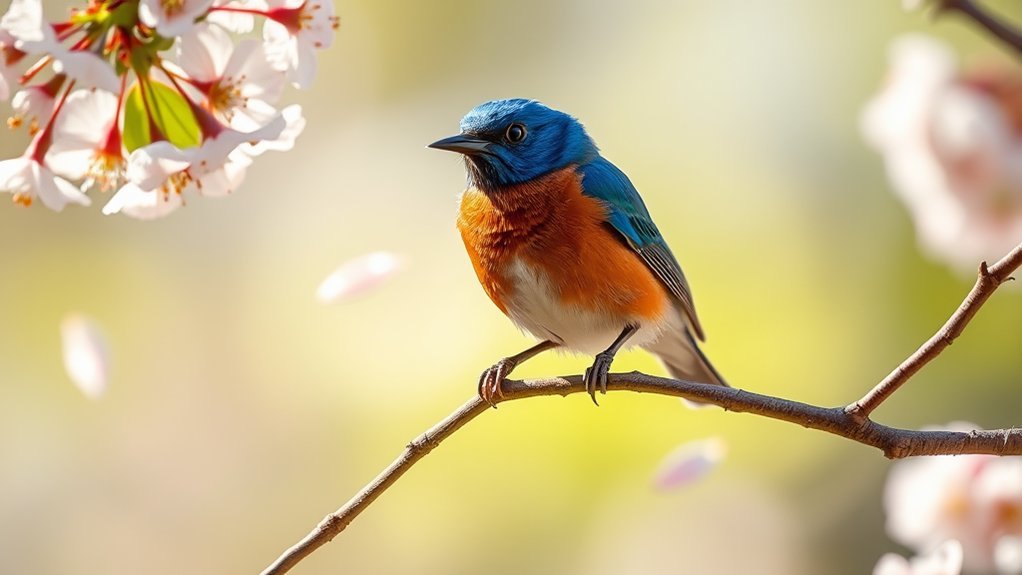What Bird Sounds Like a Squeaky Toy? Identifying the Caller
When you are birdwatching, you might hear a sound that resembles a squeaky toy. This sound is made by some bird species, notably the Carolina Wren and the American Woodcock. Each bird has its own distinct vocalization that can enhance your birdwatching experience.
The Carolina Wren is known for its cheerful, repeating calls that can mimic a squeaky toy. It usually has a warm brown color and a noticeable white eyebrow stripe. You can often find it in gardens, shrubs, and woodlands.
The American Woodcock, on the other hand, has a unique "peent" call that can also remind you of a toy. It has a stout body, long bill, and large eyes, and it prefers open fields and areas near water.
To identify these birds, pay attention to their sounds and remember their key characteristics. This will improve your birdwatching skills and make your time outdoors more enjoyable.
Key Takeaways
- The Carolina Wren sings a unique melody that sounds like a squeaky toy. This song helps mark territory and attract mates.
- The American Woodcock makes peent sounds during mating displays. These sounds can also resemble a squeaky toy.
- The Black-capped Chickadee has a playful call that sounds like "Chick-a-dee-dee-dee." This call can remind listeners of a squeaky toy and changes based on how threatened the bird feels.
- The Red-winged Blackbird has distinct and aggressive calls that are easily recognizable. These calls have a squeaky tone during mating season.
These birds live in various habitats, making them easy to observe and identify by their sounds.
Understanding Bird Vocalizations

How can you tell different bird sounds apart? Start by listening to key features like pitch, rhythm, and tone.
Some birds make beautiful, complex songs, while others use simple, repetitive calls. These sounds have different purposes. Songs often show territory or attract mates. Calls might warn others of danger or help maintain group bonds.
Pay attention to the situation; a bird's sounds can change based on its surroundings or interactions with others. As you notice these details, you'll gain a better understanding of birds.
This skill will help you connect with nature and feel included in the birdwatching community, where sharing experiences enhances everyone's journey.
The Common Ground Dove
The Common Ground Dove is a small bird that many birdwatchers admire. It has a simple beauty and unique behaviors. Known for its gentle cooing calls, this dove makes sounds during courtship and when marking its territory.
Watching its behavior makes birdwatching enjoyable. Here are some key points about the Common Ground Dove:
- Foraging: Common Ground Doves like open spaces. They search for seeds and grains on the ground.
- Mating Calls: During breeding season, their calls become more frequent, creating a pleasant sound in their environment.
- Social Behavior: They often appear in pairs or small groups, showing social interactions that are interesting to observe.
These traits highlight the charm of the Common Ground Dove and enhance the birdwatching experience.
The Eastern Whip-poor-will

The Eastern Whip-poor-will is a nocturnal bird known for its distinctive song. Its call, "whip-poor-will," resonates in the quiet of night.
Whip-poor-wills engage in unique mating rituals, where males sing repeatedly to attract females and mark their territory. They catch insects during flight, showcasing impressive agility.
As night falls, you may see their silent flight as they search for food. Understanding their calls and behaviors helps connect people with nature.
Listening to the whip-poor-will invites appreciation for these intriguing birds.
The American Woodcock
The American Woodcock is a captivating bird, especially during its unique courtship displays. Here are key facts about this interesting species:
- Active at Dusk: American Woodcocks search for food at twilight. Their brown feathers help them blend into the surroundings, keeping them safe from predators.
- Mating Flight: Male woodcocks attract females by flying in spirals. They make a series of peent sounds, which can be likened to a squeaky toy.
- Nesting Habits: They build nests close to the ground in thick vegetation. This choice protects their eggs and chicks from threats.
The American Woodcock is a remarkable bird, showcasing fascinating behaviors that enhance our appreciation of nature.
The Carolina Wren

The Carolina Wren is a small bird full of energy and charm. It thrives in dense, shrubby areas such as suburban backyards, woodlands, and thickets. This bird adapts well to different habitats, making it a pleasant sight in many regions.
Carolina Wrens display bold behavior. They explore their surroundings with lively hops. Their song is unique and melodic, often sounding like a squeaky toy. This song serves two main purposes: to mark their territory and to attract mates.
Watching Carolina Wrens interact can enhance your appreciation for them. They show strong social bonds and a deep connection to their environment, highlighting their resilience in nature.
The Blue Jay
The Blue Jay is a captivating bird known for its bright colors and smart behavior. Birdwatchers often see these birds in deciduous and mixed forests, as well as in suburban areas.
Here are some interesting facts about Blue Jays:
- Blue Jays usually forage in groups, showing their strong social lives.
- They can mimic other bird calls, which helps them communicate and warn others of danger.
- They fiercely protect their territory, demonstrating their intelligence and ability to adapt.
Learning about Blue Jay behavior helps us understand their role in the ecosystem, as they're important for seed dispersal.
The Killdeer
The Killdeer is a unique shorebird known for its distinct call and appearance. This bird lives in various places, such as fields, gravel beaches, and cities.
When you watch Killdeer, you'll see their broken-wing display, which distracts predators from their nests. They make loud calls, sounding like a squeaky toy, alerting you to their presence.
Killdeer adapt well to human environments while keeping their breeding practices intact. This adaptability makes them interesting for birdwatchers and nature lovers.
Learning about Killdeer's behaviors and habitats can help you connect with this amazing bird and its ecosystem.
The Black-capped Chickadee
The Black-capped Chickadee is a common and friendly visitor in many backyards. This bird stands out with its lively behavior and unique calls. It lives in various habitats, such as deciduous and mixed forests, and often visits feeders, showing its curious nature. Bird watchers enjoy its charming presence.
Here are three key features of the Black-capped Chickadee:
- Unique Call: The bird makes a "chick-a-dee-dee-dee" call that changes based on how threatened it feels.
- Social Nature: These birds often form small groups. They've strong social ties and work together.
- Versatility: Chickadees thrive in urban settings, often found foraging in parks and residential yards.
Watching their playful behaviors and listening to their distinctive sounds can bring joy to your outdoor experience.
The House Finch
House Finches add bright colors and cheerful songs to urban and suburban areas. They often gather in small groups and search for seeds.
These birds adapt well to different settings, including parks and neighborhoods. Male house finches are vibrant with their red feathers, while females are more muted in brown.
Their songs are simple and can sound like squeaky toys, making them a charming presence.
If you provide food and shelter, you can attract these lively finches and enjoy their company in your yard.
The Red-winged Blackbird
The call of the Red-winged Blackbird stands out in wetlands and open fields. These birds display interesting behavior, particularly during mating season when they show aggressive territoriality.
Their calls remind some people of a squeaky toy, making them easy to remember.
Here are three key features of their habitat:
- Wetlands: They live in marshes, ponds, and riversides.
- Open Fields: They often perch on tall grasses or reeds.
- Shrubby Areas: They like nesting in areas with low vegetation.
Knowing these details about the Red-winged Blackbird's habitat helps you understand their importance in the ecosystem.
The next time you hear their distinct call, you'll recognize it as belonging to this remarkable bird.
The Green Heron
Green Herons are interesting birds that live near water. They prefer wetlands, marshes, and coastal areas.
These birds like to hunt alone. They stalk and catch small fish and amphibians quickly. Their call sounds like a squeaky toy, especially during breeding season.
Green Herons use tools, like bait, to attract their prey, showing their intelligence. They adapt well to their habitat, demonstrating resourcefulness.
These traits make Green Herons appealing to nature lovers who want to observe birds in their environment.
The Mourning Dove
Mourning Doves are common birds in North America. You often hear their soft cooing in backyards and parks. Their sounds attract attention and invite observation. These doves like open areas such as suburban regions, fields, and urban settings.
Here are three important points about Mourning Doves:
- Nesting: They build nests in dense shrubs or trees, which offers protection from predators.
- Feeding: Mourning Doves mainly eat seeds and search for food on the ground in groups.
- Communication: Their unique cooing is a way for them to communicate and bond with each other.
These graceful birds add beauty to nature, making them enjoyable to watch and appreciate.
Tips for Identifying Bird Sounds
To identify bird calls in your area, focus on their song patterns. Notice the repetition of sounds, changes in pitch, and how long each note lasts.
Some birds sing in distinct rhythms, while others may use trills or whistles. Try sound mapping to visualize these patterns. You can also record calls using your phone for later review.
When you hear a new sound, compare it with calls of birds in your area. Soon, you'll connect with nature, enjoying the ability to recognize different species and their unique behaviors.
This practice enhances your appreciation for the diverse birdlife around you.
Frequently Asked Questions
What Time of Year Do Birds Make Squeaky Toy Sounds?
Birds usually make squeaky toy sounds during spring migration and the breeding season. These sounds help them mark their territory and attract mates. This behavior is important for successful reproduction and supports the growth of their populations.
Do All Birds Produce Similar Squeaky Sounds?
Birds do not produce the same squeaky sounds. Different bird species have unique calls. These calls come from their specific body structures. Each species makes sounds that vary in tone and style. This leads to a wide range of bird vocalizations that are interesting to observe and listen to.
How Can I Record Bird Sounds Effectively?
To record bird sounds effectively, use good microphones and sound recorders. Move quietly and remain patient to avoid disturbing the birds. Choose a good spot that allows you to catch clear audio without scaring them away. This way, you can enjoy the beauty of bird sounds while capturing them accurately.
Are There Specific Habitats Where Squeaky-Sounding Birds Are Found?
Squeaky habitats, such as wetlands, grasslands, and forests, are home to many bird species. In these areas, you can hear a variety of birds making interesting squeaky sounds. Exploring these environments enhances your birdwatching experience and brings more joy to your outdoor adventures. Enjoy the rich diversity of birds and their unique calls!
What Equipment Is Best for Identifying Bird Calls?
To identify bird calls effectively, use high-quality parabolic microphones and portable audio recorders. Learning sound recording techniques will improve your ability to recognize and analyze various bird vocalizations in the field. These tools will help you capture clear sounds, making it easier to distinguish different species and their calls. With practice, you'll gain confidence in identifying birds by their sounds. Enjoy the process of learning and connecting with nature while you enhance your skills!

Ava is a bird enthusiast and nature lover who has spent countless hours observing and learning about the fascinating world of birds. With a passion for sharing her knowledge and inspiring others to appreciate the beauty of birds, Ava writes about her experiences and insights on avianadmirer.com.







